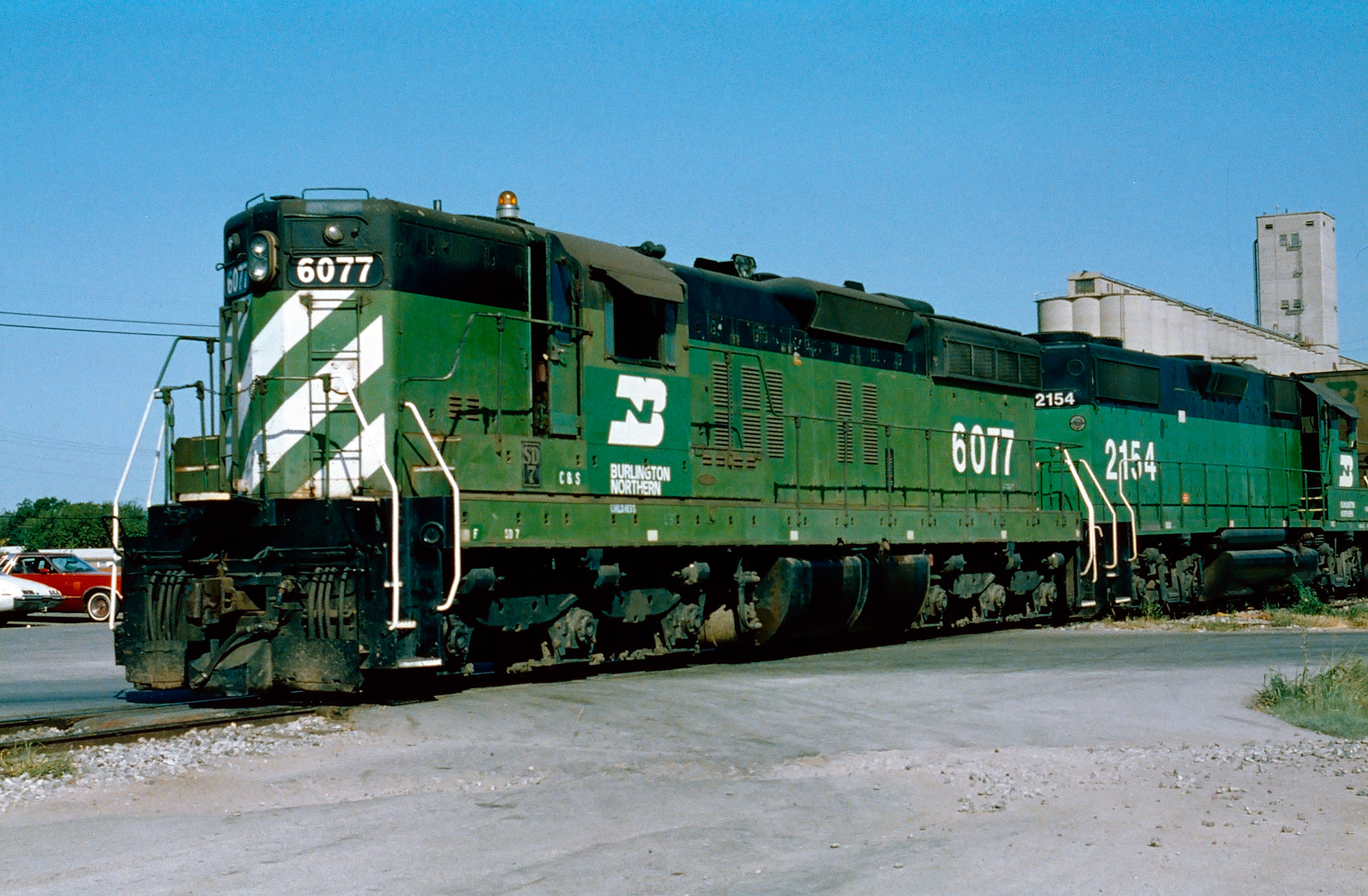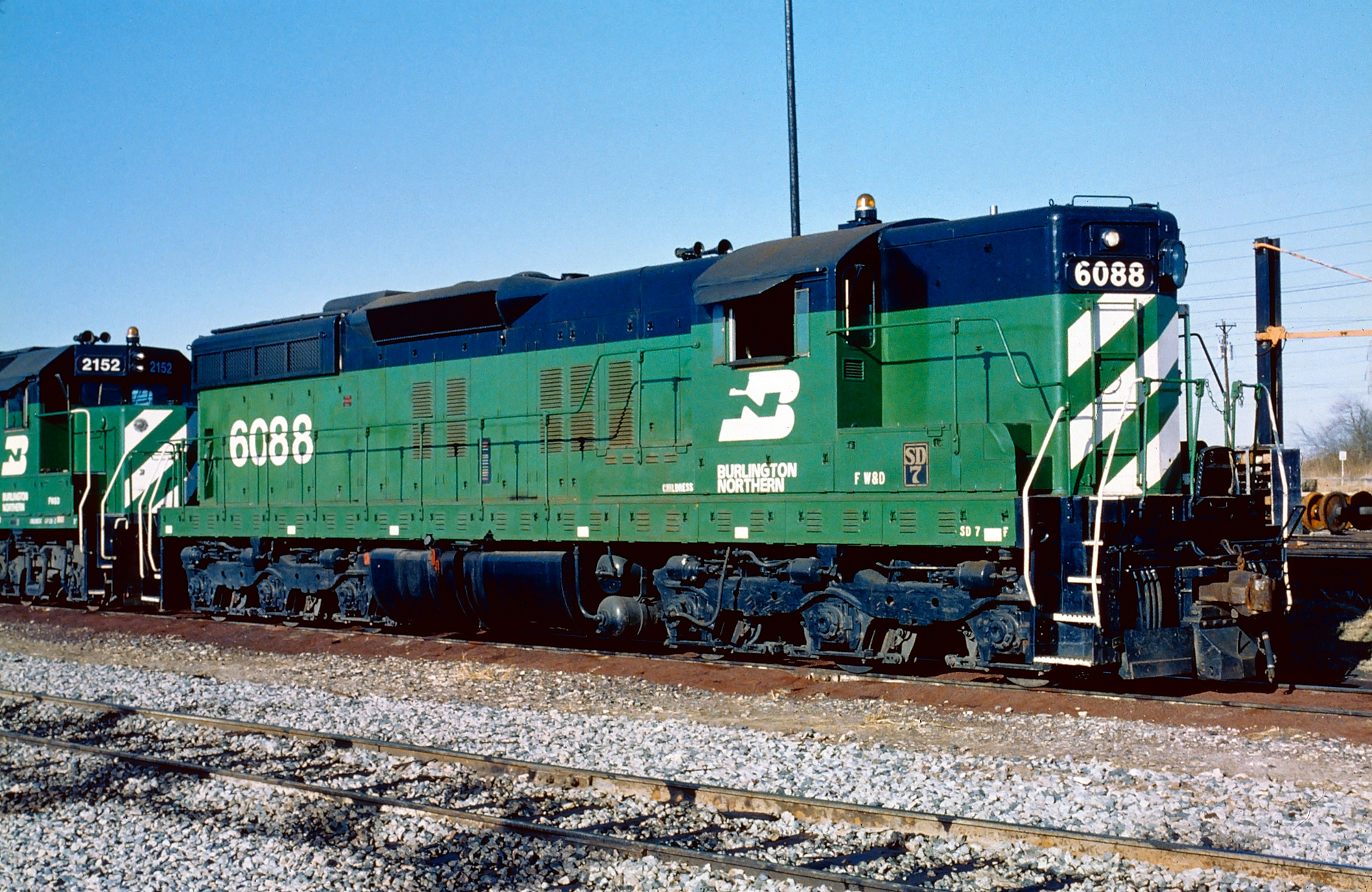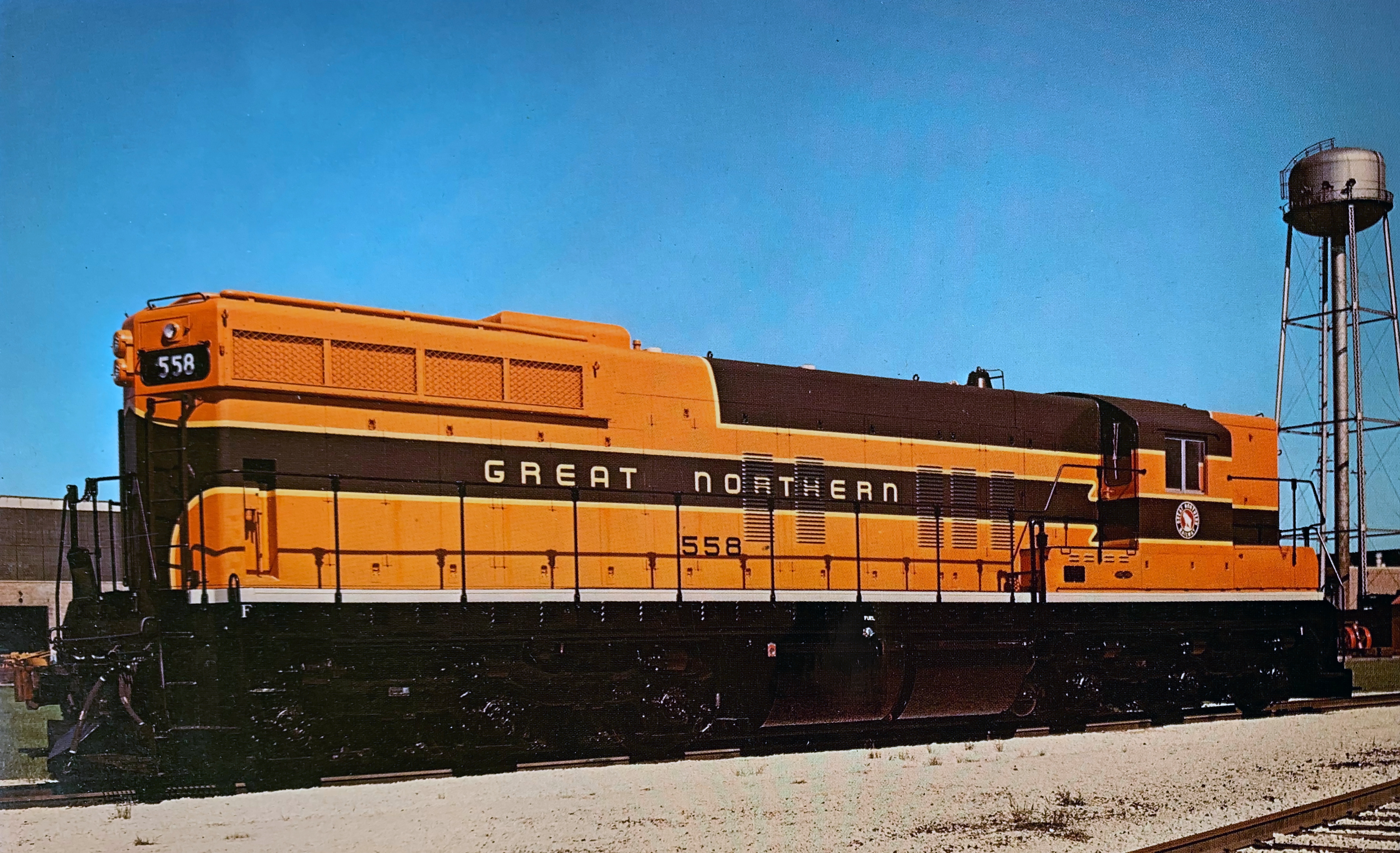EMD "SD7" Locomotives: Data Sheet, Specs, Roster
Last revised: December 17, 2024
By: Adam Burns
When Electro-Motive quietly unveiled the six-axle SD7 in 1952, company officials could have never imagined the new "Special Duty" line would one day witness unprecedented success.
Prior to its introduction, EMD had no interest in a specialized locomotive and instead remained focused on mass produced four-axle variants. At the time this included the streamlined "F" series although the builder had recently (1949) launched its own road-switcher line, the GP7.
The SD7 was the Geep's larger cousin, sporting a C-C truck arrangement that offered greater tractive effort on a longer frame but was otherwise identical. At the time, there was little interest in such a design; comparable models sold by Alco and Baldwin also found little interest.
A total of 188 SD7s were produced during a very short production run from April, 1952 to November, 1953. Interestingly, in a nod to the quality of EMD products, the model's largest buyer - Southern Pacific - rebuilt its entire fleet, which remained in service through the 1990s.
Photos
 Burlington Northern (Colorado & Southern) SD7 #6077 (built as #817) and GP38-2 #2154 at North Yard in Saginaw, Texas, circa 1983. Mike Bledsoe photo. American-Rails.com collection.
Burlington Northern (Colorado & Southern) SD7 #6077 (built as #817) and GP38-2 #2154 at North Yard in Saginaw, Texas, circa 1983. Mike Bledsoe photo. American-Rails.com collection.History
The six-motored locomotive concept was not new when EMD introduced the SD7. As Brian Solomon points out in his book, "EMD Locomotives," General Electric had offered a straight-electric in this configuration as early as 1930 when it produced 42 Class R-2 locomotives for New York Central for its West Side freight operations in New York City (Manhattan).
In addition, Alco had first offered a six-motored RS1 in 1942 for the U.S. Army while Baldwin first cataloged its own six-axle version as early as 1946, the A1A-A1A trucked DRS-6-4-1500. Two years later it unveiled the six-motored DRS-6-6-1500.
Internally, the SD7 was identical to its four-axle counterpart, equipped with a 1,500 horsepower, 16-cylinder model 567B prime mover.
However, it was also unique via a custom designed frame; by contrast, Alco and Baldwin had utilized the same basic frame in developing both their four, and six-axle models. While internally the same, the SD7 was outwardly unmistakable from the GP7.
At a length of 60 feet, 8 ½ inches over couplers, the model was more than five feet longer than its four-axle counterpart. A single locomotive could haul a 5,500-ton train on level track, climb grades as high as 5%, and negotiate curves of 23 degrees.
The SD7 also featured another unique trait, EMD's own Flexicoil truck. This lightweight, high adhesion design offered a surprisingly comfortable ride and was easy to maintain. It provided mechanics straightforward access to the center-axle, which was difficult to reach in Alco's early six-axle truck.
 Burlington Northern SD7 #6088, sub-lettered for the Fort Worth & Denver, is seen here in Fort Worth, Texas, circa 1983. Mike Bledsoe photo. American-Rails.com collection.
Burlington Northern SD7 #6088, sub-lettered for the Fort Worth & Denver, is seen here in Fort Worth, Texas, circa 1983. Mike Bledsoe photo. American-Rails.com collection.Reception
In the early 1950s, railroads still preferred four-axle locomotives in main line freight service. As a result, reception to EMD's early six-axle variants was cool.
Nevertheless, there was some interest, especially by Southern Pacific, which tested out the builder's bright red demonstrator, #990, and ultimately purchased this unit. In fact, SP wound up with the largest fleet, 43 of the 188 examples produced.
Data Sheet and Specifications
| Entered Production | 4/1952 (Milwaukee Road #2200) |
| Years Produced | 4/1952 - 11/1953 |
| Engine | 567B |
| Engine Builder | GM |
| Horsepower | 1500 |
| RPM | 800 |
| Cylinders | 16 |
| Length | 60' 8 ½" |
| Height (Top Of Rail To Top Of Cab) | 15' 0" |
| Width | 10' 8" |
| Weight | 300,000-360,000 Lbs |
| Fuel Capacity | 1200 Gallons |
| Air Compressor | Gardner-Denver |
| Air Compressor Model | WBO |
| Air Brake Manufacturer | Westinghouse |
| Air Brake Schedule | 6BL |
| Trucks | C-C |
| Truck Type | Flexicoil |
| Truck Wheelbase | 13' 7" |
| Wheel Size | 40" |
| Traction Motors | D27C (6), GM |
| Primary Generator | D12B, GM |
| Auxiliary Generator | Delco |
| Alternator | D14 |
| MU (Multiple-Unit) | Yes |
| Dynamic Brakes | Yes |
| Gear Ratio | 65:12, 62:15, 61:16, 60:17, 59:18, 58:19 |
| Tractive Effort (Starting) | 90,800 Lbs at 25% |
| Tractive Effort (Continuous) | 75,000 Lbs at 9.3 mph |
| Top Speed | 55 mph (65:12), 65 mph (62:15), 71 mph (61:16), 77 mph (60:17), 83 mph (59:18), 89 mph (58:19) |
Production Roster
Total Built = 188
| Owner | Road Number(s) | Serial Number(s) | Order Number | Completion Date |
|---|---|---|---|---|
| Milwaukee Road | 2200-2208 | 15612-15620 | 5139 | 4/1952-6/1952 |
| Milwaukee Road | 2209-2211 | 15621-15623 | 5201 | 6/1952, 8/1952 |
| Electro-Motive (Demonstrator) | 990 (became Southern Pacific #5308) | 15624 | 7512 | 10/1952 |
| Great Northern | 550-564 | 16099-16113 | 5146 | 5/1952-10/1952 |
| Nevada Northern | 401 | 16824 | 6397 | 8/1952 |
| Milwaukee Road | 2212-2214 | 16941-16943 | 5144 | 6/1952 |
| Fort Worth & Denver City (Burlington) | 850-857 | 17121-17128 | 6468 | 3/1953 |
| Colorado & Southern (Burlington) | 810-817 | 17129-17136 | 6274 | 1/1953-2/1953 |
| Bessemer & Lake Erie | 801-803 | 17138-17140 | 6436 | 10/1952 |
| Southern Pacific | 5279-5293 | 17144-17156 | 5157 | 11/1952-1/1953 |
| Colorado & Southern (Burlington) | 818-819 | 17260-17261 | 6274 | 2/1953 |
| Chicago, Burlington & Quincy | 400-411 | 17396-17407 | 5140 | 11/1952-12/1952 |
| Minneapolis & St Louis | 852, 952 | 17408-17409 | 5181 | 12/1952 |
| Electro-Motive (Demonstrator) | 991 (became Baltimore & Ohio #760) | 17410 | 6457 | 3/1952 |
| Kennecott Copper Corporation | 903 | 17411 | 6456 | 12/1952 |
| Great Northern | 565-572 | 17896-17903 | 5182 | 3/1953-4/1953 |
| Bessemer & Lake Erie | 451-455 | 17904-17908 | 5212 | 4/1953 |
| Fort Worth & Denver City (Burlington) | 858-860 | 17921-17923 | 5249 | 10/1953 |
| Denver & Rio Grande Western | 5300-5304 | 18124-18128 | 5232 | 5/1953 |
| Chicago & North Western | 1661-1664 | 18223-18227 | 5185 | 5/1953 |
| Chicago & North Western | 1660 | 18227 | 5276 | 6/1953 |
| Union Pacific | 775-781 | 18284-18290 | 5244 | 6/1953 |
| Union Pacific | 783-784 | 18291-18292 | 5277 | 6/1953 |
| Union Pacific | 782 | 18293 | 5278 | 6/1953 |
| Milwaukee Road | 2215-2219 | 18301-18305 | 5274 | 10/1953 |
| Milwaukee Road | 2220-2223 | 18306-18309 | 6516 | 10/1953 |
| Central of Georgia | 201 | 18310 | 6512 | 5/1953 |
| Chicago, Burlington & Quincy | 300-324 | 18320-18344 | 5242 | 5/1953-10/1953 |
| Southern Pacific | 5316-5335 | 18381-18400 | 5188 | 8/1953-9/1953 |
| Southern Pacific | 5309-5313 | 18401-18405 | 5282 | 7/1953 |
| Southern Pacific | 5314 | 18406 | 5283 | 7/1953 |
| Southern Pacific | 5315 | 18407 | 5286 | 7/1953 |
| Pennsylvania | 8588-8589 | 18669-18670 | 5300 | 10/1953 |
| Baltimore & Ohio | 761-764 | 18683-18686 | 5303 | 11/1953 |
 An Electro-Motive photo showcasing new Great Northern SD7 #558 in the summer of 1952. American-Rails.com collection.
An Electro-Motive photo showcasing new Great Northern SD7 #558 in the summer of 1952. American-Rails.com collection.Demonstrators
In designing the SD7, EMD intended it to be used in light branch service. The truck itself was lightweight and its additional axle could more evenly distribute the locomotive's weight over a greater distance, a handy trait in territory where rail was generally light.
Interestingly, the Flexicoil proved so successful it remained EMD's standard through the early 645 series which included the SD38, SD40, and SD45. It was finally replaced with the "Dash 2" line, which carried the new HT-C truck.
EMD's second demonstrator, #991, was purchased by the Baltimore & Ohio, which went on to roster five examples, #760-765. Other buyers included the Milwaukee Road, Great Northern, Nevada Northern, Burlington (and subsidiaries), Bessemer & Lake Erie, Minneapolis & St Louis, Kennecott Copper Corporation, Rio Grande, Chicago & North Western, Union Pacific, Central of Georgia, and Pennsylvania.
Interestingly, SP kept their SD7s in service - following an extensive rebuild program into SD7Rs, through the end when the railroad merged with Union Pacific in 1996.
Sources
- Foster, Gerald. A Field Guide To Trains. New York: Houghton Mifflin, 1996.
- Hayden, Bob. Diesel Locomotives: Cyclopedia, Volume 2 (Model Railroader). Milwaukee: Kalmbach Publishing Company, 1980.
- Marre, Louis A. Diesel Locomotives: The First 50 Years, A Guide To Diesels Built Before 1972. Milwaukee: Kalmbach Publishing Company, 1995.
- Pinkepank, Jerry A. Diesel Spotter's Guide. Milwaukee: Kalmbach Publishing Company, 1967.
- Schafer, Mike. Vintage Diesel Locomotives. Osceola: MBI Publishing, 1998.
- Solomon, Brian. EMD Locomotives. Minneapolis: MBI Publishing Company, 2006.
Recent Articles
-
Rio Grande 2-8-2 Locomotives (Class K-28): Specs, Roster, Photos
Apr 14, 25 10:24 PM
Rio Grande's Class K-28 Mikados were its newest narrow-gauge steam locomotives since the Mudhens of the early 1900s. Today, three survive. -
Rio Grande K-27 "Mudhens" (2-8-2): Specs, Roster, Photos
Apr 14, 25 05:40 PM
Rio Grande's Class K-27 of 2-8-2s were more commonly referred to as Mudhens by crews. They were the first to enter service and today two survive. -
C&O 2-10-4 Locomotives: Specs, Roster, Photos
Apr 13, 25 04:07 PM
Chesapeake & Ohio's T-1s included a fleet of forty 2-10-4 "Texas Types" that the railroad used in heavy freight service. None were preserved.


